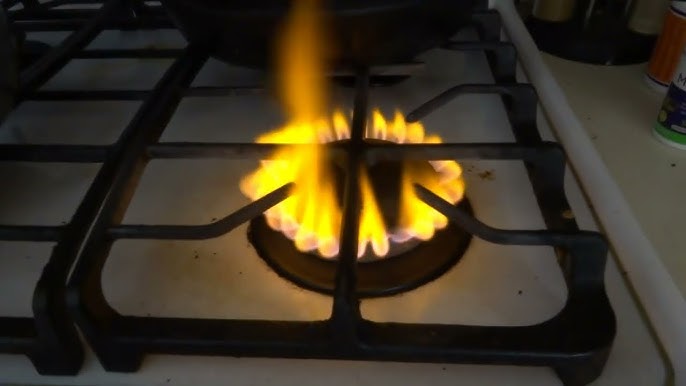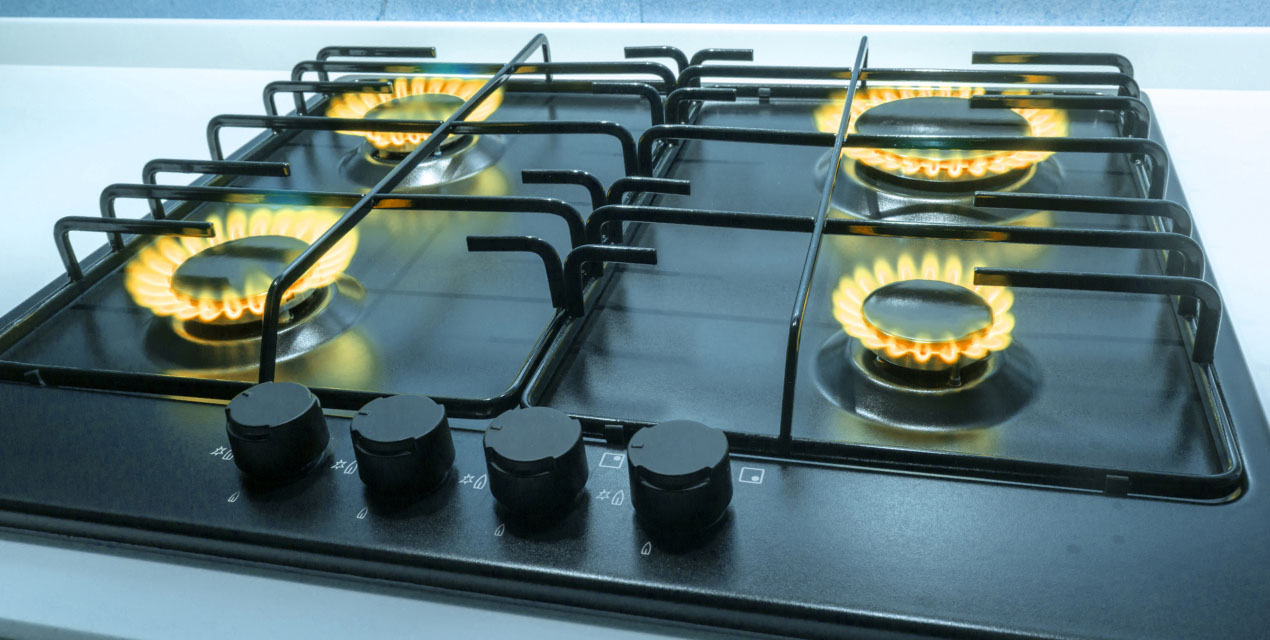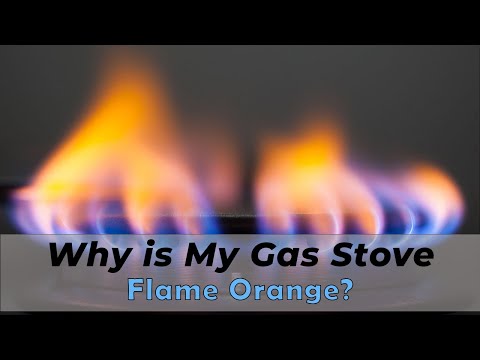
Introduction
Overview Of The Gas Stove And Its Functionalities
Gas stoves are a common and convenient choice for cooking in many households. They rely on natural gas as a fuel source to generate the heat needed for cooking purposes. Gas stoves consist of burners that emit flames, which are typically blue in color, indicating a proper ratio of oxygen for combustion.
The Significance Of Flame Color In A Gas Stove
The color of the flame produced by a gas stove can provide important information about its combustion process. A blue flame indicates efficient combustion, where the fuel gas and oxygen are being properly mixed and burnt. However, if the flame appears yellow or orange, it suggests an improper ratio of oxygen for combustion.
When a gas stove emits orange flames, it is usually a sign that the stove has become contaminated with something. One common cause is the presence of calcium or other mineral deposits on the burners. This contamination can affect the proper mixing of fuel gas and oxygen, leading to incomplete combustion and the production of orange flames.
If the orange flame is temporary and occurs intermittently, it could be due to dust particles or a dirty burner. In such cases, a thorough cleaning of the burner can help restore the proper combustion and eliminate the orange flame. However, if the flame continues to burn yellow or orange consistently, it may indicate a more serious problem that requires professional assistance.
In conclusion, the color of the flame produced by a gas stove is an important indicator of its combustion process. While blue flames signify proper combustion, yellow or orange flames suggest an imbalance in the oxygen-to-fuel ratio. Identifying and addressing the underlying cause of orange flames in a gas stove is crucial to ensure efficient and safe operation.
Understanding Gas Stove Flames
Different Flame Colors And Their Meanings
Gas stoves emit flames that can be blue, yellow, or orange in color, each indicating a different combustion scenario:
- Blue Flame: A blue flame is the desired color for a gas stove flame. It indicates that the fuel gas and oxygen are being properly mixed and burned, resulting in efficient combustion.
- Yellow or Orange Flame: The presence of a yellow or orange flame suggests an imbalance in the ratio of oxygen to fuel gas. This imbalance can be caused by factors such as contamination or inadequate airflow, leading to incomplete combustion.
Why Gas Stove Flames Are Typically Blue
A blue flame is the standard color for gas stove flames due to the proper mixture of fuel gas and oxygen. The specific reasons for this include:
- Efficient Combustion: The correct ratio of fuel gas and oxygen allows for efficient combustion, ensuring that the stove functions optimally.
- Complete Combustion: The blue flame indicates that the fuel gas is being fully burned, resulting in minimal emissions and waste.
- Safety: A blue flame signifies that the stove is operating within safe conditions, as it avoids the release of harmful byproducts.
- Energy Efficiency: Blue flames indicate that the gas stove is utilizing fuel and oxygen efficiently, leading to energy savings and cost-effectiveness.
In conclusion, the color of the flame produced by a gas stove is an important indicator of its combustion process. While a blue flame signifies proper combustion, a yellow or orange flame suggests an imbalance in the oxygen-to-fuel ratio. Identifying and addressing the underlying cause of orange flames in a gas stove is crucial to ensure efficient and safe operation.
The Mystery Of Orange Flames
Reasons Behind Orange Flames On A Gas Stove
Gas stoves are designed to emit flames that are typically blue in color, indicating efficient combustion. However, if you notice orange flames coming out of your gas stove, it may be a cause for concern. The change in flame color is often due to various factors:
- Contamination: One of the most common reasons for orange flames on a gas stove is contamination. Contaminants, such as calcium, can affect the proper mixing of fuel gas and oxygen, resulting in an imbalance and incomplete combustion.
- Inadequate airflow: Another factor that can lead to orange flames is inadequate airflow. Insufficient oxygen supply can affect the combustion process and cause the flame to turn yellow or orange.
- Gas pressure: Irregular gas pressure can also contribute to the change in flame color. If the gas pressure is too low or too high, it can disrupt the proper mixture of fuel gas and oxygen, leading to incomplete combustion.
Potential Dangers Associated With Orange Flames
While a blue flame indicates efficient and safe operation, the presence of orange flames on a gas stove can pose certain risks:
- Incomplete combustion: Orange flames suggest that the fuel gas is not being fully burned, resulting in incomplete combustion. This can release harmful byproducts, such as carbon monoxide, which can be dangerous if inhaled.
- Energy waste: Orange flames indicate inefficiency in the combustion process, leading to energy waste. Inefficient combustion not only increases your energy consumption but can also lead to higher utility bills.
- Safety hazards: Orange flames can indicate a malfunction or problem with the gas stove, which could potentially cause leaks or other safety hazards. It is important to address the cause of orange flames promptly to ensure the safe operation of your gas stove.
If you notice orange flames on your gas stove, it is recommended to take the following steps:
- Clean the burner: If contamination is the cause, clean the burner thoroughly to remove any debris or deposits.
- Check for adequate airflow: Ensure that there is proper ventilation and airflow around your gas stove.
- Contact a professional: If the issue persists or you are unsure about the cause, it is best to contact a qualified technician who can inspect and repair your gas stove.
In conclusion, understanding the reasons behind orange flames on a gas stove is crucial for maintaining the efficiency, safety, and proper functioning of your appliance. If you encounter this issue, addressing it promptly can help prevent any potential dangers and ensure optimal performance.

Carbon Monoxide Concerns
The Link Between Orange Flames And Carbon Monoxide
When you notice orange flames on your gas stove, it is important to be aware of the potential presence of carbon monoxide. Carbon monoxide is a colorless and odorless gas that can be produced as a byproduct of incomplete combustion. The change in flame color suggests that the fuel gas is not being fully burned, leading to the release of this harmful gas.
Risks Of Carbon Monoxide Exposure
Exposure to carbon monoxide can have serious health consequences. If inhaled, carbon monoxide can displace oxygen in the blood, leading to a condition called carbon monoxide poisoning. Symptoms of carbon monoxide poisoning include headaches, dizziness, nausea, and even unconsciousness. In severe cases, it can be life-threatening.
If you suspect carbon monoxide is present in your home due to orange flames on your gas stove, it is important to take immediate action to protect yourself and your family:
- Open windows and doors to provide ventilation and fresh air.
- Turn off the gas stove and any other potential sources of carbon monoxide in your home.
- Leave the premises and go to a safe location outside, away from the potential source of carbon monoxide.
- Contact emergency services or a professional carbon monoxide detector to assess the situation and ensure your safety.
Remember, carbon monoxide is a silent killer, and it is crucial to prioritize your safety when dealing with a potential carbon monoxide leak. Regular maintenance and inspection of your gas stove by a qualified technician can help prevent such incidents and ensure the proper functioning of your appliance.
Identifying The Cause
Potential Causes Of Orange Flames On A Gas Stove
When orange flames are observed on a gas stove, it is crucial to identify the underlying cause to ensure safe and proper functioning of the appliance. Some potential factors that can lead to orange flames include:
- Improper gas flow: Orange flames may indicate an improper flow of gas, which can be caused by a variety of issues such as a clogged burner or a faulty gas valve. It is important to address this issue promptly to prevent further damage and potential safety risks.
- Combustibles in the air: The presence of combustible materials near or in the air can affect the flame color. It is essential to ensure that the area around the gas stove is clear of any flammable objects or substances.
- High humidity: High levels of humidity in the home can also contribute to the change in flame color. This is because increased moisture in the air can interfere with the combustion process, resulting in orange flames.
- Carbon in the air: The presence of carbon particles in the air can cause the flame to turn orange. This can happen when there is incomplete combustion, and carbon is being burned in the flame.
How To Troubleshoot And Determine The Underlying Issue
If you notice orange flames on your gas stove, here are some troubleshooting steps you can take to determine the underlying issue:
- Check for any obstructions: Inspect the burner and ensure it is not clogged or blocked by debris. Clean the burner thoroughly if necessary.
- Verify the gas supply: Ensure that the gas valve is fully open and there are no issues with the gas supply. If you suspect a gas leak, turn off the gas stove immediately and contact a professional for assistance.
- Remove any combustibles: Clear the area around the gas stove of any flammable materials or substances.
- Control humidity levels: If high humidity is a recurring issue, consider using a dehumidifier in the kitchen or improving ventilation.
- Seek professional help: If the issue persists or you are unsure about troubleshooting on your own, it is recommended to contact a qualified technician to inspect and repair the gas stove.
Remember, addressing orange flames promptly is essential to prevent potential safety hazards and ensure the proper functioning of your gas stove. It is always recommended to prioritize safety and seek professional assistance when needed.
Calling A Professional
When And Why To Seek Professional Assistance
If you have followed the troubleshooting steps mentioned above and are still experiencing orange flames on your gas stove, it is recommended to call a professional for assistance. Here are some instances when you should consider seeking professional help:
- Persistent issue: If the problem persists even after attempting to troubleshoot, it indicates a more complex issue that requires professional expertise.
- Gas leak suspicion: If you suspect a gas leak, it is crucial to immediately turn off the gas stove and contact a professional technician. Gas leaks can be extremely dangerous and should be dealt with by a qualified individual.
- Safety concerns: If you are unsure about conducting further troubleshooting on your own or if you feel uncomfortable working with gas appliances, it is best to leave the job to a professional. They have the knowledge and experience to handle the situation safely.
- Warranty coverage: If your gas stove is still under warranty, it is advisable to contact the manufacturer or an authorized service center to avoid voiding the warranty.
The Importance Of Regular Maintenance
Regular maintenance of your gas stove is essential to ensure its optimal performance and prolong its lifespan. Employing the services of a professional technician for regular maintenance can provide the following benefits:
- Efficient and safe operation: Regular maintenance helps to identify and address any potential issues before they develop into major problems. It ensures that the gas stove is operating efficiently and safely.
- Energy and cost savings: A well-maintained gas stove functions more efficiently, resulting in reduced energy consumption and lower utility bills.
- Extended lifespan: By detecting and resolving any minor issues during maintenance, the lifespan of your gas stove can be extended, saving you from premature replacement costs.
- Peace of mind: Knowing that your gas stove has been professionally inspected and maintained provides peace of mind, allowing you to focus on cooking without worrying about any potential safety or performance issues.
In conclusion, if you observe orange flames on your gas stove, it is essential to address the issue promptly to ensure safety and proper functioning. While troubleshooting can be done on your own, seeking professional assistance is recommended if the problem persists or if there are safety concerns. Additionally, investing in regular maintenance by a professional technician can help maximize the efficiency and lifespan of your gas stove.

Preventive Measures
Tips To Ensure The Proper Functioning And Safety Of Your Gas Stove
To prevent the occurrence of orange flames on your gas stove and maintain its optimal performance, here are some preventive measures you can take:
- Regular cleaning: Keep your gas stove clean by regularly removing food debris, grease, and dirt. This helps to prevent blockages that can affect the flame color and quality.
- Check for gas leaks: Regularly inspect your gas stove for any signs of gas leaks, such as a strong odor of gas or hissing sounds. If you suspect a gas leak, turn off the gas supply immediately and seek professional assistance.
- Proper ventilation: Ensure that the area around your gas stove is well-ventilated to prevent the accumulation of gas and combustion byproducts. Proper ventilation helps maintain a steady and healthy flame.
- Avoid using improper cookware: Use cookware that is suitable for gas stoves. Improperly sized or coated cookware can cause uneven heat distribution, leading to orange flames.
- Schedule regular maintenance: Invest in regular maintenance by a professional technician to ensure your gas stove is in good condition. This includes checking for any gas leaks, inspecting the igniter, and cleaning the burner ports.
Ways To Prevent Orange Flames
To specifically prevent orange flames on your gas stove, consider the following steps:
- Adjust the air shutter: The air shutter controls the air-to-gas ratio, which affects flame color. Consult your stove’s manual to locate the air shutter and adjust it according to the manufacturer’s instructions.
- Check the gas pressure: Low gas pressure can result in orange flames. Contact a professional technician to measure and adjust the gas pressure if necessary.
- Replace faulty parts: If you notice any damaged or worn-out parts, such as the burner or gas valve, replace them promptly. Faulty parts can impact flame color and the overall functioning of your gas stove.
By following these preventive measures and taking prompt action if you notice orange flames on your gas stove, you can ensure the safety and proper functioning of this essential appliance in your home. Remember that seeking professional assistance is crucial when needed to address complex issues or safety concerns associated with your gas stove.
Other Flame Colors
Understanding The Significance Of Different Flame Colors
Different flame colors on a gas stove can indicate various issues with your appliance. Here are some common flame colors and what they might signify:
- Blue flame: This is the ideal flame color for a gas stove. A blue flame indicates a proper flow of gas and efficient combustion. It is a clean and even flame that provides optimal cooking performance.
- Orange flame: An orange flame, as mentioned earlier, can be a sign of an improper gas flow and potential excess of carbon monoxide. This can pose a serious safety risk and should be addressed promptly.
- Yellow flame: A yellow flame on a gas stove can indicate that the burner needs cleaning or adjustment. It may be caused by dirt, food debris, or a misalignment of the burner ports. A yellow flame can affect the cooking experience and efficiency.
- Red or purple flame: If you notice a red or purple flame on your gas stove, it might indicate the presence of impurities or contaminants in the gas supply. This could be due to a malfunctioning gas valve or an issue with the gas source. It is important to investigate and resolve this issue to ensure safe operation.
What To Do If You Notice Flame Colors Other Than Blue Or Orange
If you observe flame colors other than blue or orange on your gas stove, it is essential to take appropriate action to address the issue. Here are some steps you can follow:
- Clean and inspect the burner: Remove any food debris, grease, or dirt from the burner and its ports. Ensure that the burner is correctly aligned and properly seated.
- Adjust the air shutter: If the flame color is yellow, try adjusting the air shutter according to the manufacturer’s instructions to achieve a bluer flame.
- Check for gas leaks: If you suspect a gas leak or notice any unusual odors or hissing sounds, immediately turn off the gas supply and contact a professional technician for assistance.
- Seek professional help: For complex issues or if you are unsure about troubleshooting, it is advisable to seek the expertise of a professional technician. They can diagnose and resolve any underlying problems with your gas stove.
By being aware of different flame colors and taking appropriate measures, you can ensure the safety, efficiency, and optimal performance of your gas stove. Regular maintenance and prompt attention to any irregularities can help prevent potential hazards and extend the lifespan of your appliance.
Conclusion
The color of the flame on your gas stove can provide valuable information about the efficiency and safety of your appliance. Understanding the significance of different flame colors is crucial in identifying potential issues and taking appropriate action.
Final Thoughts On Gas Stove Flame Color And Safety
It is important to note that a blue flame is the desired color for a gas stove, indicating proper gas flow and efficient combustion. Any other colors, such as orange, yellow, red, or purple, may indicate problems that need attention.
Summary Of Key Points And Recommendations
Here are the key points to remember when it comes to gas stove flame colors:
- Blue flame: Ideal and indicates proper gas flow and efficiency.
- Orange flame: Can be a sign of improper gas flow or excess carbon monoxide, requiring prompt attention.
- Yellow flame: May indicate the need for cleaning or adjustment of the burner.
- Red or purple flame: Could suggest impurities or contaminants in the gas supply, requiring investigation.
If you notice flame colors other than blue or orange, it is recommended to:
- Clean and inspect the burner.
- Adjust the air shutter to achieve a bluer flame if it appears yellow.
- Check for gas leaks and contact a professional if necessary.
Regular maintenance and professional assistance can ensure the safety, efficiency, and optimal performance of your gas stove. By addressing any irregularities promptly, you can prevent potential hazards and prolong the lifespan of your appliance.
Gas stoves are commonly used in millions of households worldwide, providing a convenient and efficient way to cook food. However, it is essential to be aware of the color of the flame on your gas stove, as it can provide valuable information about its functionality and safety. In this FAQ, we will delve into the mysteries surrounding the significance of an orange flame on a gas stove.
FAQ
Q: What does it mean if the flame on my gas stove is orange?
A: An orange flame on a gas stove could indicate a problem with the burner or the gas supply. Typically, a healthy gas flame should be predominantly blue in color. So, an orange flame could suggest that the mixture of gas and air is not balanced.
Q: Why is it important to have a blue flame instead of an orange one?
A: The blue color in a gas flame indicates that there is sufficient oxygen for the combustion to occur efficiently. A well-adjusted burner should produce a blue flame with a small, inner cone of yellow. On the other hand, an orange flame signifies incomplete combustion, potentially releasing harmful byproducts like carbon monoxide.
Q: What can cause an orange flame on a gas stove?
A: Several factors can contribute to the presence of an orange flame. These include:
- Air ventilation: Insufficient airflow can result in an orange flame. Check if vents or air passages around the stove are blocked.
- Dirty burner: Dust, dirt, or food residue can clog burner holes, affecting the air-to-gas ratio and causing an orange flame. Regularly cleaning the burners can help resolve this issue.
- Gas pressure: Low gas pressure can lead to an incomplete combustion process, causing an orange flame. Contact a professional to check the gas pressure in your system.
- Gas quality: Poor gas quality or a contaminated gas supply can also contribute to an orange flame. Contact your gas provider to address any concerns.
Q: How can I fix an orange flame on my gas stove?
A: Here are a few troubleshooting steps you can take:
- Clean the burners: Remove any dirt or debris from the burners and burner holes using a soft brush or a toothpick. Avoid using water or anything that may cause damage.
- Check air vents and passages: Ensure that there is proper ventilation around the stove by clearing any obstructions or blockages around the stovetop and ventilation areas.
- Verify gas pressure: If you suspect low gas pressure, contact a certified technician to assess and adjust the pressure accordingly.
- Consult a professional: If the problem persists or you are unsure about how to proceed, it is always recommended to call a qualified professional to inspect and resolve the issue.
Remember, safety should always be a top priority when dealing with gas appliances. If you detect the smell of gas, hear unusual hissing sounds, or experience other safety concerns, immediately turn off the gas supply and contact your gas provider.

Noel Martinez, the owner of theholygrillsf.com, uses social media to connect with the community and share delicious updates from The Holy Grill. Follow Noel Martinez for mouthwatering food photos, exciting event announcements, and behind-the-scenes glimpses into the world of The Holy Grill. Stay in the loop and never miss out on the latest culinary adventures!